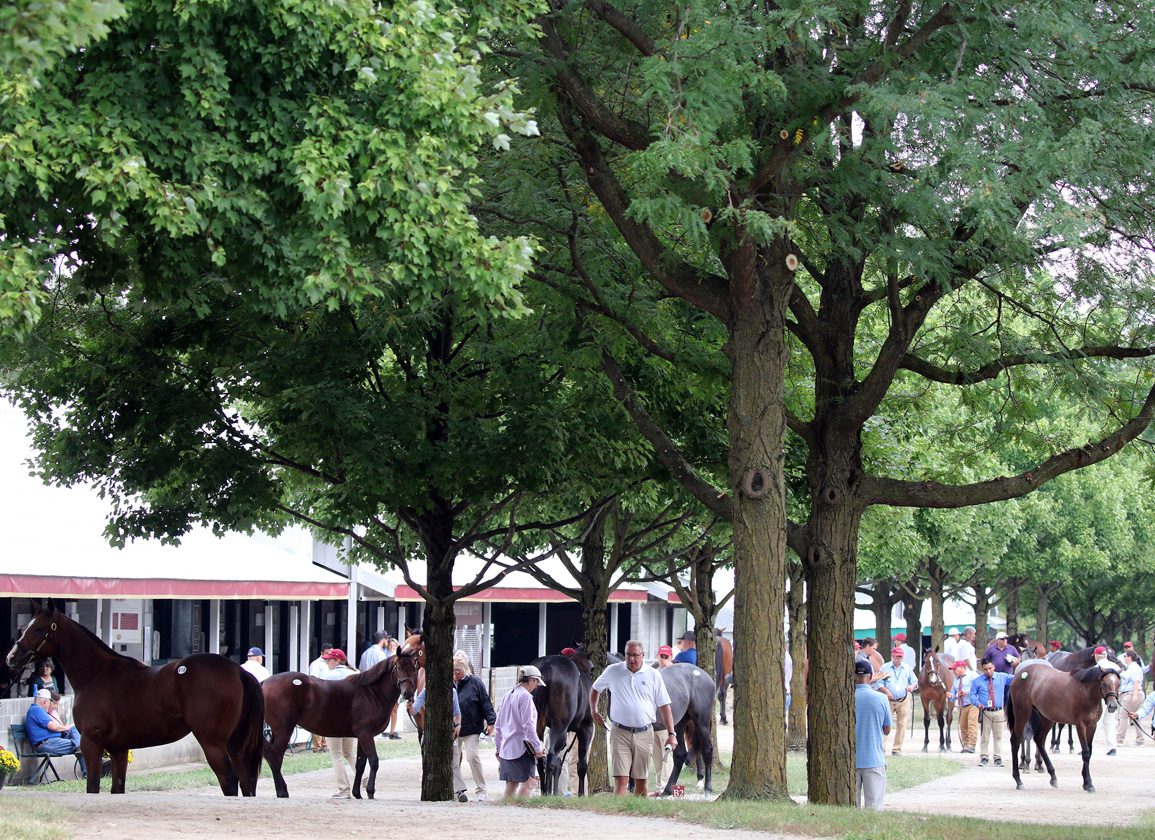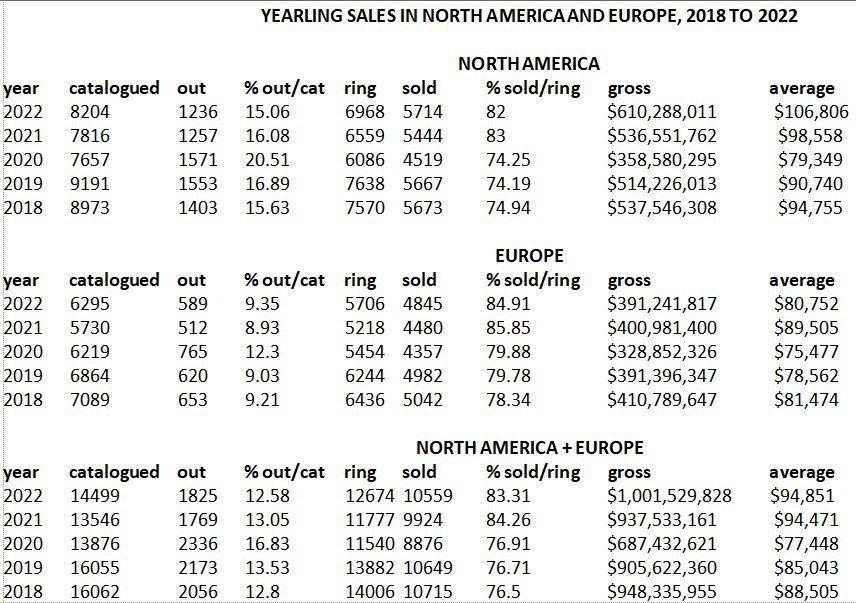By Chris McGrath
It's a long time now, some 40 years or so, since Nelson Bunker Hunt's notorious observation that “a billion dollars isn't what it used to be”. Which presumably means that today it's no longer even quite what it was, back when it wasn't what it used to be. After all, we've just seen the dispersal of a single art collection–assembled by the late Paul Allen, co-founder of Microsoft–realize $1.5 billion. Nonetheless it feels as though the transatlantic yearling market, in 2022, has reached a pretty historic landmark in tipping 10 figures for the first time.
Though a couple of minor catalogues remain to be processed in Europe, the overall value of yearling trade in North America and Europe has already advanced $63,996,667 (6.8%) on the 2021 tally of $937,533,161 to smash a symbolic barrier at $1,001,529,828.
Even in a marketplace currently inuring us to records, with one auction after another achieving new high-water marks, it's pretty staggering to register a first-ever crop of “billion dollar babies”.
This figure, moreover, crushes very strong internal growth in the European market under the weight of a dollar that has been leaning heavily on other currencies in general, and sterling in particular.
That's perfectly valid, in that the upper tier of the European market is dominated by international rather than domestic investment. For those who count their wealth in dollars–the kind of people buying Mr. Allen's Klimts and Cezannes–the quaint old “guinea” has proved an especially congenial means of conducting business this year.
So while turnover and averages at Tattersalls and elsewhere have been soaring giddily, year on year, dollar conversion actually confines the value of the European market to a degree that would astonish its indigenous participants. In those terms, it has actually shed 2.4% this year, down to $391,241,817 from $400,981,400 in 2021. While we naturally pass over the COVID-warped turnover of 2020 (weighed in at $328,852,326), the European market this year was virtually identical to 2019, at the prevailing dollar rate, and down 4.8% on $410,789,647 in 2018. That's a chastening correction of perspective, for any Europeans attributing a booming export market to the sheer quality of their product.
Consider Europe's premier yearling catalogue through the prism of a fluctuating exchange rate. In October 2014, when £1 would get you $1.59, the average Book I yearling at Tattersalls realized $393,893. After the Brexit referendum in 2016, sterling having slumped to $1.22, the same book averaged $292,168. And this year, with sterling bumping along the floor at $1.12, a “record” average for the sale converted to just $280,080. So while the average guinea cost of a Book I yearling has gained 26.6% since 2014, the average dollar cost has meanwhile come down by 28.9%. (Jolly well done, Brexit supporters!)
Of course, the pinhooker who buys and sells within the European market, or the breeder who pays a covering fee there, will also buy their bread and milk in the same currency. So their sense that business is booming is perfectly legitimate, and its suppression within these figures–unprecedented as they are–only goes to show how remarkably potent is the current bull run in international bloodstock.
The flattening of European growth by dollar conversion leaves the average cost of a 2022 yearling, either side of the Atlantic, virtually unchanged at $94,851. In North America, however, we have reached a landmark every bit as stunning as the $1-billion overall market. In 2022, the average American yearling broke six figures, up from $98,558 last year to $106,806.
Once again, then, we renew our perplexity about this market's peculiar immunity to rampant geopolitical and economic maladies out there in the real world. We know that its most affluent contributors were never asked to furl the cash umbrellas they were issued after the banking crisis, and many have now separated themselves altogether from the exposure being experienced by the rest of society. Yet after a decade of spending stimulus, interest rates have finally been dusted off to tackle such forgotten inflationary horrors as plague and invasion. And somehow this market is still humming along.
The demand is real. Forget aggregate turnover, look at the astounding clearance rate. This has historically been less robust in America, but whereas 75% of those entering the ring here in 2018 found a new home–and that was a better clip than in the three preceding years–in the last two years the tally has climbed to 83 and 82% respectively. In Europe, similarly, the 2018 clearance of 78% has been moved up to as high as 86 and 85%.
So how does this all hold together? The stallion farms certainly appear to be taking their cue. Some of their fees for next spring arguably (and understandably) claim a piece of the action. Several elite stallions are getting steep hikes, on both sides of the water, in some cases at a time of life when their quality has been long established. But the organic connection between yearling values and covering fees entitles farm accountants to seize the day.
Over the past week, moreover, we have also seen how some unusually glamorous new stallions are stimulating demand for the most eligible mares. And while the gentleman who gave $4.6 million for 2.5% of Flightline can comfort himself that the underbidders set standards in the astute calculation of bloodstock values, this horse has reminded us–despite the notorious brevity of his first career–of the economic potential of sheer fan power.
That's significant, because for now there's limited crossover between those spending at Keeneland this week, and those spending in the same ring back in September. It's heartening that so many people want to buy racehorses; and especially that many are doing so because viability on the track, in some parts of the country, feels increasingly feasible. But the circle still needs to be completed. If demand is so high, then why is supply diminishing? Why is the North American foal crop still to revive after its post-2008 collapse?
After the banking crisis, we soaked up four consecutive crop drops between 5.9 % and 12.7%. There followed three years of stability before numbers began to ebb again, down 4.4% in 2018 even as the market was booming. Obviously we've since had a big COVID-shaped punch to the belly, but the projected crop for 2023 is again down.
As we know, the racing program–notably its black-type tier–has not sufficiently matched that contraction to remain competitive, and therefore stimulating to handicappers. The legal wagering menu is expanding all the time, and our own demographic is ageing.
It is true that crop sizes little different from today (c.18,000) serviced the American sport adequately in the era when it still retained a mass following. And the huge leap in the Thoroughbred population actually came after that heyday, from the mid-1960s to the mid-1980s, instead being driven by a revolution in the commercial breeding environment.
In this latest cycle of demand, however, we see no corresponding rise in supply. We've had a bull run for several years now, even riding out the pandemic with surprising resilience, yet the foal crop has meanwhile stagnated at best.
Doubtless there are many different reasons for that. But one big difference between now and the couple of decades leading to the peak of 1986 (over North American 50,000 foals) is the failure of the export market. Those years of revolution owed significant impetus to European stables. (And rightly so, as things turned out: the result was a game-changing regeneration of the European Thoroughbred.)
Now I'm not going bother with an umpteenth rebuke for the disastrous modern schism between the two gene pools, and therefore the two markets. Nowadays, after all, I consider that more of an opportunity than a problem: if I'm right, then those who share my views will cash in; and if I'm wrong, then there's no need to gnash any teeth.
Nonetheless one or two collective responsibilities do need to be embraced. How, for instance, to retrieve that European faith? Many of the prejudices that have stifled investment are actually thoroughly misguided. Nonetheless reconciliation could be a valuable incidental benefit from the earnest embrace of HISA.
In the domestic market, meanwhile, how do we excite all these people buying racehorses with the idea of breeding them? As things stand, this buoyancy at the sales ring does not yet fit any coherently virtuous circle of engagement.
You couldn't say that Californian racing is thriving simply because it has produced nearly all the recent champions most likely to engage new fans: Zenyatta, California Chrome, American Pharoah, Justify, Flightline. Yet while other local barometers remain dispiriting, notably purses and fields, at least its leaders have made the tough decisions necessary to secure a more sustainable footing for any other progress that can be made. They have started from the ground up, literally, with their racing surfaces–and have done such a good job that they might yet prove able to turn round some of their other issues.
By the same token, just because horsemen elsewhere are making plenty of dough, whether in the ring or on the track, that doesn't mean they can be complacent that everything else is in place. For a time, remember, the price of silver told Bunker Hunt that he had just about nailed his attempt to corner the market. Let's be cautious, then, before deciding that all the glister on our Thoroughbreds must be gold.
Not a subscriber? Click here to sign up for the daily PDF or alerts.









